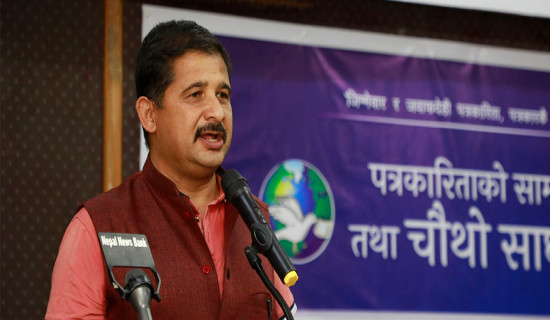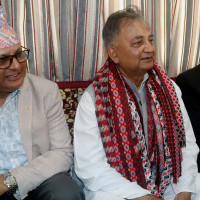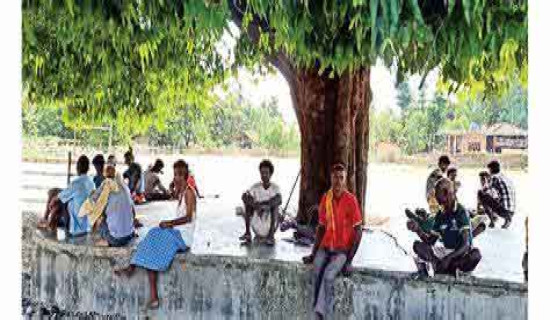- Sunday, 19 May 2024
Credibility Is Gorkhapatra’s Asset
Nepali journalism now stands at a crossroads. With the phenomenal rise of digital media, traditional media such as radio, television and newspapers are facing an existential crisis. The emergence of Artificial Intelligence (AI) has posed another formidable challenge to the entire media as well as creative realms. As the evolution of online papers has almost reached a point of saturation, the print and electronic media are struggling to prove their relevance. A significant number of TV channels have been shut down. So is the fate of newspapers. It is not merely a shift to the online media that has brought a crisis to them. Lingering economic crisis, triggered by the COVID-19 pandemic, largely shrank the bulk of their income generated from advertisement business. A limited market means drying up of revenues for a majority of media outlets. Only a handful of media houses can come through Darwinian struggle for survival.
Financial trouble has a crippling impact on the sustenance and operation of media outlets but there is also another key factor – crisis of credibility - that has negative implications for the professional development of the sector. The media companies’ nefarious nexus with politics and business has badly undermined impartiality and accuracy, the cardinal values of journalism. Of late, we have confronted an unpleasant scenario – while some newspapers and TV channels stopped operating, some big media houses have been dragged into controversy. They are accused of dishing out biased news and information, targeting certain persons with whom they disagree.
Trustworthiness
Overcoming economic trouble and credibility deficit is the key to media houses to effectively fulfil their responsibility. Seen from this perspective, Gorkhapatra, the state-run publication house, stands at a safe position. As an autonomous body, Gorkhapatra’s financial health is undeniably sound. Similarly, it provides verified news and unvarnished views to the readers so that the latter are not misled at a time when the spread of fake news, disinformation and misinformation has increased at an alarming rate. These detrimental factors have led to a drastic reduction in the trustworthiness of media worldwide. For example, a recent Gallup poll reveals that only 32 per cent people trust mass media in the USA. Inclination to resort to partisan approach and build false narratives to meet vested commercial and geopolitical interest can be attributed for terrible slide in the truthfulness of media content.
On the other hand, as a record newspaper, Gorkhapatra has been a source of authenticity for readers and researchers alike. Its relevance and resilience stand out even in the time of ubiquitous digital media. Riding on the easily affordable internet, digital papers are also competing with each other to reach out to wider segments of readers and viewers. In a race to beat a rival, they are also sidestepping the basic media ethics and standards, resulting in the erosion of public trust in them. This is a reason why the people turn to the print media to make sure that the information they know is correct. And Gorkhapatra has now become a reliable source for the readers to authenticate news.
When Gorkhapatra was born as the country’s first newspaper on May 6, 1901, its original mission was to disseminate correct information to the people without fear or favour. This has been attested by the sanad (decree) issued by its founder – reformist Rana prime minister Dev Shumsher. It states: “The paper should not publish our (the Prime Minister’s) praise and plaudits.” This is indeed a revolutionary guidance to the nascent paper that took shape as the nation was under the autocratic rule of the Ranas. Dev Shumsher apparently sought to develop it as a credible public media that would inform the public about his administration’s activities and air the genuine aspirations of people themselves.
Barring some hard political news, Gorkhapatra has served as a vibrant public sphere where citizens’ voices are articulated through an objective depiction of social, economic and cultural problems. Similarly, the Nepali vernacular daily has played a critical role in promoting language, literature and culture, thereby uniting the people from diverse ethnic and linguistic backgrounds. Unlike the private media houses, Gorkhapatra does not allow commercial and geopolitical elements to manipulate its content. It is true that those who have clout in the corridors of power attempt to use/abuse its publications for their publicity but this does not stifle the overall objective of the paper.
Innovative approach
Despite its unwavering credibility and commitment to quality journalism, Gorkhapatra requires structural reforms on administrative, financial and editorial fronts. Gorkapatra Corporation (GC) management needs to adopt an innovative approach to explore new sources of incomes in view of dwindling advertisement transactions. One way to boost the business is to revamp the online department that mostly relies on journalists working on the contract basis. It should be equipped with latest technology and competent workforce so that its services become efficient, fast and up to date. News is uploaded and updated minute by minute. Any news report posted an hour back becomes stale for the online readers. So, the Corporation must be prepared to deal with these challenges brought by the fast-paced internet development.
Incentive, motivation and timely career growth of employees is essential to enable the oldest publication house to compete with its rivals and serve the people better. Many public enterprises have been weighed down by the bloated size of bureaucracy in the country and GC is not an exception. It is imperative to ensure a proportionate balance when it comes to filling the vacancies for different departments. With its half a dozen publications, the GC as a cultural entity that wields soft power to promote national interest and unite the Nepali people from diverse political, ethnic and linguistic backgrounds. Thus, Gorkhapatra is a national heritage and the government and political parties should embrace a common viewpoint to promote and preserve it. On the occasion of its 124th anniversary today, all stakeholders should reflect on its strength and weaknesses, and work on a strategic vision to transform it into a robust public media capable of coping with emerging challenges.
(The author is Deputy Executive editor of this daily.)







-square-thumb.jpg)







